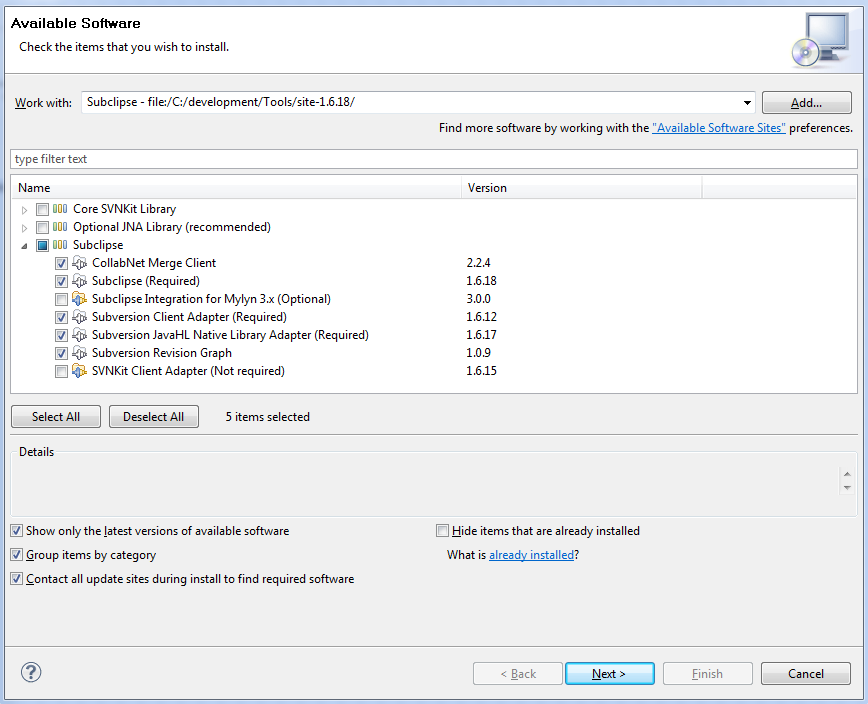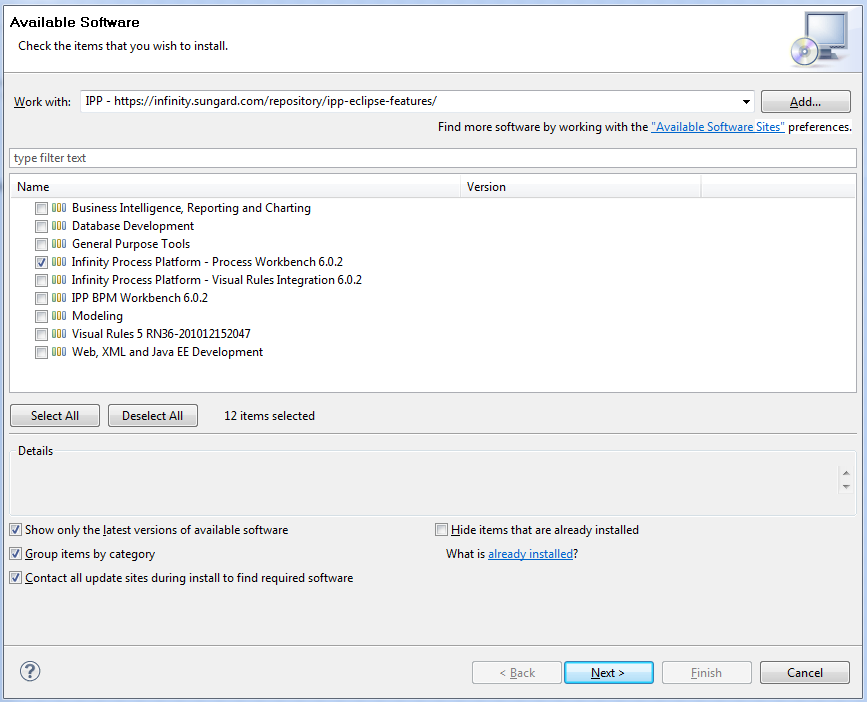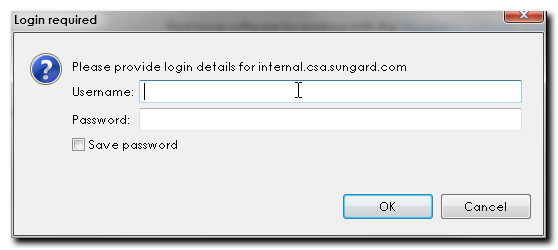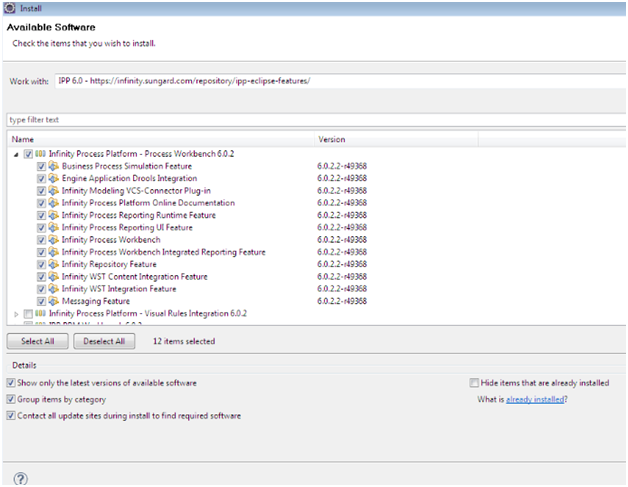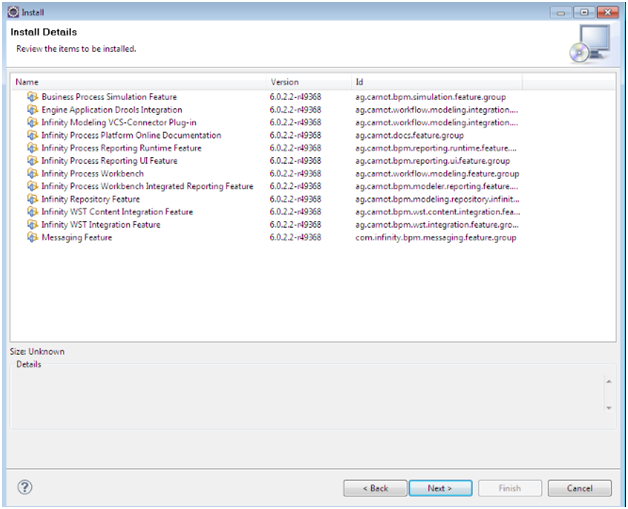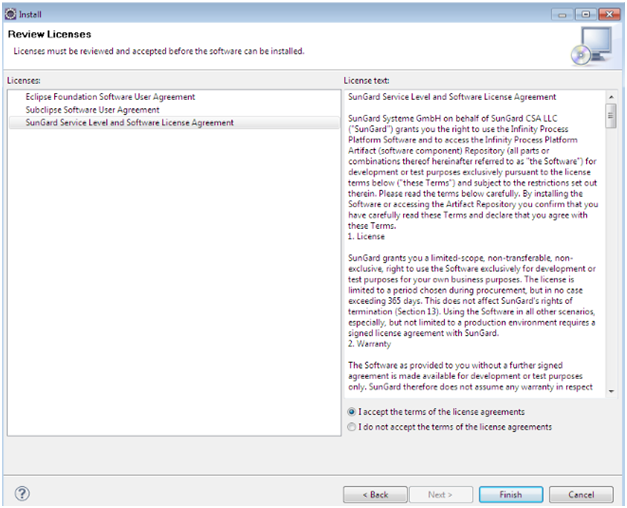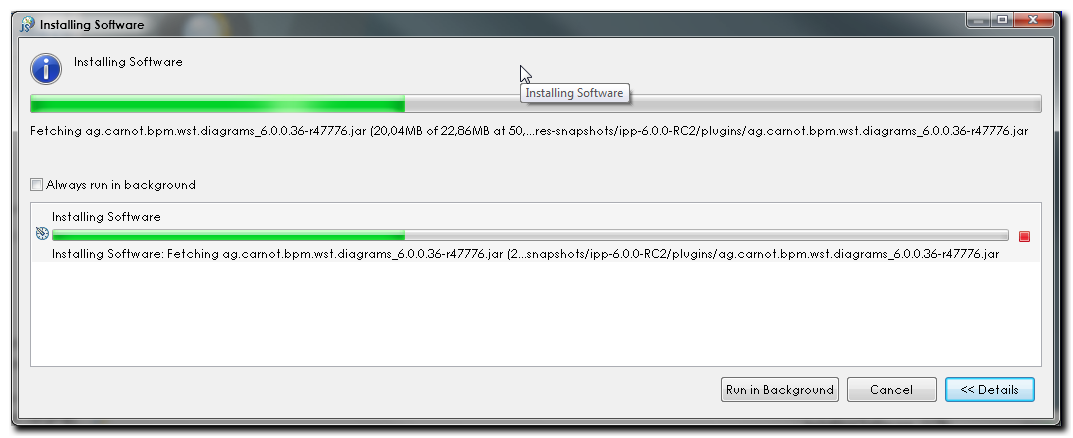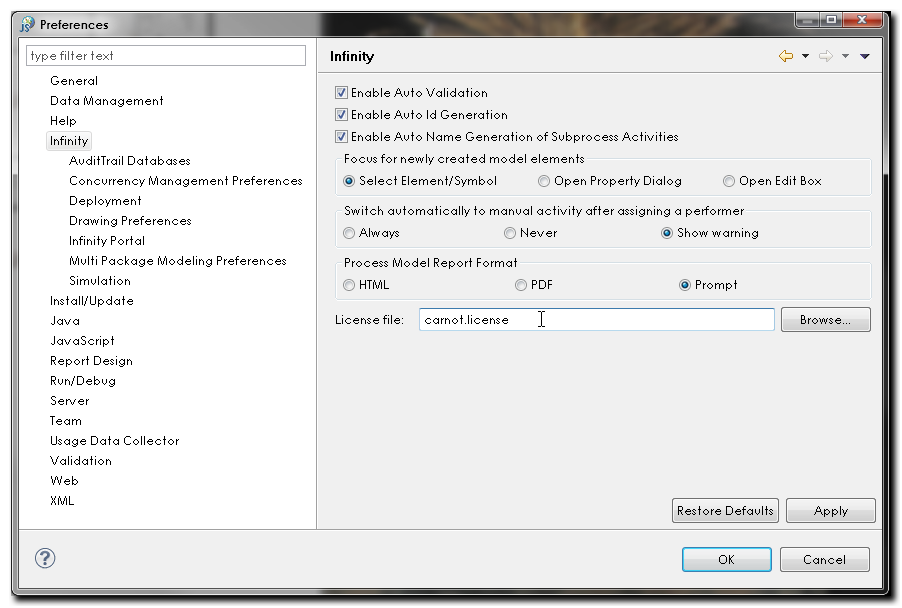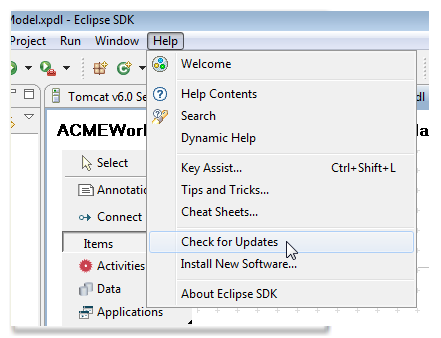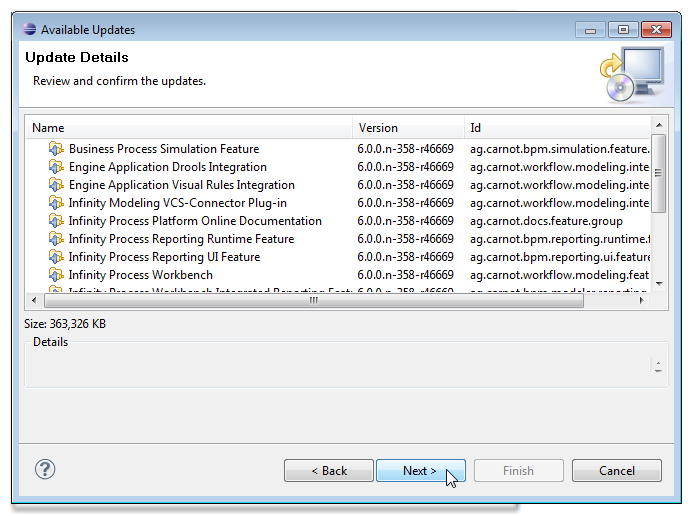Notice: this Wiki will be going read only early in 2024 and edits will no longer be possible. Please see: https://gitlab.eclipse.org/eclipsefdn/helpdesk/-/wikis/Wiki-shutdown-plan for the plan.
Difference between revisions of "Stardust/Knowledge Base/Getting Started/Installation"
m |
m |
||
| Line 32: | Line 32: | ||
<br> | <br> | ||
| − | + | [[Image:Installing Stardust via Eclipse update 01.png]] | |
<br> | <br> | ||
| − | + | <p>'''Note:''' Select '''Infinity Process Platform Visual Rules Integration''' only if this functionality is required and '''Visual Rules 5 RN36-201012152047''' plug-in bundle has been installed up-front. If Subclipse plug-ins have not been installed already, please unselect '''Infinity Modeling VCS-Connector''' plug-in.</p> | |
| − | + | ||
| − | + | ||
<br> | <br> | ||
| − | + | <p>Screenshot: Login screen</p> | |
| + | [[Image:Installing Stardust via Eclipse update 04.png]] | ||
| − | + | <br> | |
| − | + | <p>Screenshot: Selected plug-ins screen</p> | |
| + | [[Image:Installing Stardust via Eclipse update 05.png]] | ||
| − | + | <br> | |
| − | [[Image:Installing Stardust via Eclipse update | + | <p>Screenshot: Review screen</p> |
| + | '''[[Image:Installing Stardust via Eclipse update 06.png]]''' | ||
| − | + | <br> | |
| − | + | <p>Screenshot: License Agreement screen</p> | |
| + | '''[[Image:Installing Stardust via Eclipse update 07.png]]''' | ||
| − | + | <br> | |
| − | + | ||
| − | + | ||
| − | '''[[Image:Installing Stardust via Eclipse update 08.png]] | + | <p>Screenshot: Installation progress screen</p> |
| + | '''[[Image:Installing Stardust via Eclipse update 08.png]]''' | ||
Once installation is finished, a dialog appears suggesting to restart, which you should do. The Process Workbench requires a license file to be present. To load it, select '''Preferences''' and go to the '''Infinity''' section. Type the path to the license file or click '''Browse''' to locate it. Click '''Apply''' or '''OK.''' | Once installation is finished, a dialog appears suggesting to restart, which you should do. The Process Workbench requires a license file to be present. To load it, select '''Preferences''' and go to the '''Infinity''' section. Type the path to the license file or click '''Browse''' to locate it. Click '''Apply''' or '''OK.''' | ||
Revision as of 10:14, 8 November 2011
Contents
Eclipse Update Site
The Process Workbench is based on the Eclipse Platform and consists of the combination of the basic Eclipse platform and a number of plug-ins which can be installed from the online update site. Currently the IPP plug-ins are only supported for the Eclipse version Eclipse Helios Sr2 (3.6.2). Please make sure to download exactly the version appropriate for your operating system. It’s recommended to download the bundle Eclipse IDE for Java and Report Developers to avoid downloading BIRT-related plug-ins at later point via Eclipse update site.
After downloading, install Eclipse by unzipping it into a target folder of your choice. Start the Eclipse application. When the Eclipse IDE opens for the first time you are presented with a Welcome screen, which you may close.
In order to use Collaborative Modeling feature you will be needing the VCS-Connector plug-in, which itself requires Subclipse 1.6.17. The fastest and most stable way to install Subclipse plug-ins is to download the local update site from here, extract it to your local drive and install it into Eclipse prior any Infinity Process Platform related installation activities.
- Go to Help > Install New Software...
- Add new local update site Subclipse pointing to the location to where you have extracted Subclipse archive
- Chose newly created local update site and select plug-ins such as shown in screenshot below
- Confirm all possible follow up screens
- Restart Eclipse after installation
After installation of Subclipse plug-ins, Infintiy Process Platform related plug-ins can be installed.
- Go to Help > Install New Software...
- Add new remote update site IPP pointing to https://infinity.sungard.com/repository/ipp-eclipse-features/
- Chose IPP remote update site and when asked for a login type in the credentials (e-mail/password) you used when registering at the Infinity Storefront
- Select Infinity Process Platform - Process Workbench 6.x
- Confirm all possible follow up screens
- Restart Eclipse after installation
Note: Select Infinity Process Platform Visual Rules Integration only if this functionality is required and Visual Rules 5 RN36-201012152047 plug-in bundle has been installed up-front. If Subclipse plug-ins have not been installed already, please unselect Infinity Modeling VCS-Connector plug-in.
Screenshot: Login screen
Screenshot: Selected plug-ins screen
Screenshot: Review screen
Screenshot: License Agreement screen
Screenshot: Installation progress screen
Once installation is finished, a dialog appears suggesting to restart, which you should do. The Process Workbench requires a license file to be present. To load it, select Preferences and go to the Infinity section. Type the path to the license file or click Browse to locate it. Click Apply or OK.
Turn to the integrated documentation to learn more about the Process Workbench. The included documentation for the Process Workbench can be found under the Help > Help Contents menu item and then selecting the chapter for Infinity Process Platform Documentation.
Enjoy using Infinity Process Workbench until you can use it as Stardust as an even more integral part of the Eclipse project!
Receiving Artifacts from the Maven Repository
Additionally to the Workbench Artifacts, Infinity provides the following artifacts and scripts:
- Runtime artifacts
- Client scripts
- Spring configurations
- Web artifacts like deployable archives and configuration snippets
- Infinity Scan
These components are available by the ipp-tools artifact. You can download this artifact directly from the artifactory from the following location:
https://infinity.sungard.com/repository/ipp-libs/com/infinity/bpm/ipp-tools/
or by an Ivy integrated Ant task as described in the following section.
- Retrieving the Artifacts via Ivy Integrated Ant Tasks
- Building your Work Environment via Ivy Integrated Ant Tasks
- Including Thirdparty Libraries
Retrieving the Artifacts via Ivy Integrated Ant Tasks
You can use Apache Ivy ant tasks to receive the artifacts and build your work environment. For details on using Ivy, please refer to the Apache Ivy Site.
You can use the following code snippets for the files needed to be configured:
ivy.xml
<?xml version="1.0" encoding="UTF-8"?>
<ivy-module version="2.0" xmlns:m="http://ant.apache.org/ivy/maven" xmlns:xsi="http://www.w3.org/2001/XMLSchema-instance"
xsi:noNamespaceSchemaLocation="http://ant.apache.org/ivy/schemas/ivy.xsd">
<info organisation="<organisation.name>" module="<ipp-client-tool>" revision="<x.y.z>" />
<configurations>
<conf name="ipp-tools" />
</configurations>
<dependencies>
<dependency org="com.infinity.bpm" name="ipp-tools" rev="" conf="ipp-tools->default">
<artifact name="ipp-tools" type="zip"/>
</dependency>
</dependencies>
</ivy-module>
|ivy-settings.xml
<?xml version="1.0" encoding="UTF-8"?>
<ivysettings>
<property name="ipp.m2.repository" value="https://internal.csa.sungard.com/artifactory" override="false"/>
<property name="default.ivy.cache" value="/.cache" override="false"/>
<caches>
<cache name="ipp-tools-ivy-cache" basedir="" useOrigin="true" />
</caches>
<resolvers>
<ibiblio name="ipp-releases" root="/ipp-libs" m2compatible="true" cache="ipp-tools-ivy-cache"/>
</resolvers>
<settings defaultResolver="ipp-releases"/>
</ivysettings>
build.xml
<?xml version="1.0" encoding="UTF-8"?>
<project name="retrieve-ipp-tools" default="retrieve-ipp-tools" xmlns:ivy="antlib:org.apache.ivy.ant">
<property name="ivy.install.version" value="2.2.0" />
<property name="ivy.jar.dir" value="/ivy" />
<property name="ivy.jar.file" value="/ivy.jar" />
<property name="ivy.settings.file" value="ivy-settings.xml" />
<property name="m2.server.host" value="internal.csa.sungard.com" />
<property name="m2.server.auth.realm" value="Artifactory Realm" />
<property name="m2.server.auth.username" value="<i>username</i>" />
<property name="m2.server.auth.password" value="<i>password</i>" />
<property name="ipp.version" value="latest.integration" />
<!-- Downloading ivy -->
<target name="download-ivy" unless="skip.download" description="Downloading ivy">
<mkdir dir=""/>
<get src="http://repo1.maven.org/maven2/org/apache/ivy/ivy//ivy-.jar" dest="" usetimestamp="true"/>
</target>
<!-- Installing ivy -->
<target name="install-ivy" depends="download-ivy" description="Installing ivy">
<path id="ivy.lib.path">
<fileset dir="" includes="*.jar"/>
</path>
<taskdef resource="org/apache/ivy/ant/antlib.xml" uri="antlib:org.apache.ivy.ant" classpathref="ivy.lib.path"/>
</target>
<!-- Setting up ivy -->
<target name="setup-ivy" depends="install-ivy" description="Setting up ivy">
<ivy:settings id="ivy.instance" file="">
<ivy:credentials host="" realm="" username="" passwd="" />
</ivy:settings>
</target>
<!-- Retrieving IPP Tools -->
<target name="retrieve-ipp-tools" depends="setup-ivy" description="Retrieving IPP Tools">
<ivy:resolve/>
<ivy:retrieve conf="ipp-tools" pattern="[artifact].[ext]" type="zip"/>
<unzip dest="." src="ipp-tools.zip"/>
</target>
</project>
Run the build file to retrieve the ipp-tools.zip archive. Please take care to use the right proxy settings in your Java environment.
Building your Work Environment via Ivy Integrated Ant Tasks
Unzip the downloaded or created ipp-tools.zip file.
After doing so, you find a ipp-ivy-cred.properties file in the etc folder. Open this file and set the appropriate user and password, e.g.:
m2.server.host = internal.csa.sungard.com m2.server.auth.realm = Artifactory Realm m2.server.auth.username = <i>username</i> m2.server.auth.password = <i>password</i>
All needed Ivy files are downloaded as well:
- ivy.xml - to declare the project's modules and dependencies.
- ivy-settings.xml - to configure artifact resolution.
- build.xml - to execute the ANT tasks for artifact resolution.
Now execute the ANT target retrieve-ipp-tools, which you find in the provided build.xml file.
All artifacts like documentation, runtime, client scripts etc., will be downloaded. To get an overview about the runtime dependencies, you can execute the ANT target report of the build.xml file. Per default, the latest integration is used to retrieve the appropriate version. Thus, you always get the latest version, that can be found in the repository. If you are interested in a specific version, you can either pass the version via a parameter, e.g.
<tt>-Dipp.version=6.0.2</tt>
or you can permanently store this parameter in the etc/build.properties file.
Including Third party Libraries
You need to set up a custom repository to include the following third party libraries:
- jai-imageio-1.1.jar - javax.media.group-id
- stax-ex-1.0.jar - org.jvnet.staxex
- streambuffer-0.4.jar - com.sun.xml.stream.buffer
In your ivy-settings.xml, add your custom repository in the resolvers section, e.g.:
<ibiblio name="ipp-nondistributable" root="/ipp-3rd-party-nondistributable" m2compatible="true" cache="ipp-tools-ivy-cache"/>
In the chain section, add a reference to this repository:
<chain name="pull-ipp-deps"> ... <resolver ref="ipp-nondistributable" /> ... </chain>
Upgrading and Downgrading Installed Features
You have the option to upgrade or downgrade installed features. The following sections describe the necessary steps to be performed:
Upgrading Features
To upgrade your installed features to a later version provided in the repository, perform the following steps:
- In the main menu, select Help > Check for Updates.
- The Available Updates dialog opens. Select the updates you like to install. In the Version column, the newest version to update to is displayed.
- Review and confirm your selected updates and click Next.
- Accept the license and select Finish.
- Restart Eclipse.
If upgrading to a new version in an already configured environment, also take care to perform the necessary steps to upgrade your Web project and model accordingly, as described in chapter Upgrading to Later Versions.

